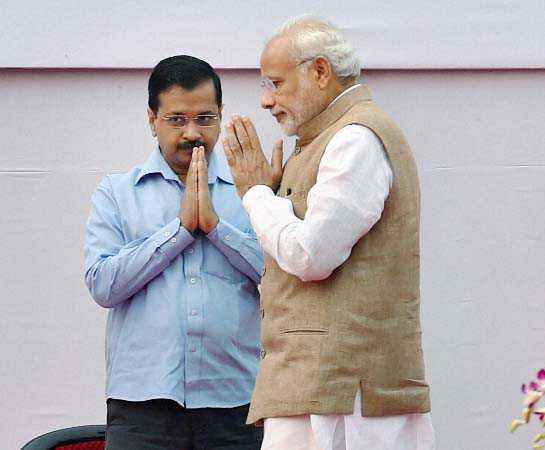
‘Chhota modi’: Nursing big ambitions, Kejriwal needs to be his own person.
S Nihal Singh
WHILE upping the ante against the Modi government, Delhi’s Chief Minister Arvind Kejriwal has amply demonstrated that his quest is to replace the Congress as the alternative to the BJP. His belief in the future is reinforced by his feeling that the Congress is fighting Mr Narendra Modi with yesterday’s tools.
With Mr Modi’s singular victory in the 2014 Lok Sabha election, he had changed the paradigm of contesting elections. It is modern technology at the service of partisan ends. And in his two years in office as Prime Minister, he has honed his talent for dramatic and eye-catching slogans mixed with stinging attacks on the Opposition in state Assembly election campaigns.
Indeed, Mr Modi has been willing to sacrifice his task as a unifier by virtue of being the country’s leader at the altar of securing a majority in the Rajya Sabha, dependent as it is on his party’s performance in state Assemblies. He is trying to succeed in this contradictory double act by extensive foreign travels in which his role as emerging India’s pre-eminent leader and the adulation of the Indian diaspora drown out dissent at home.
In his own way, Mr Kejriwal has been copying the Modi formula. After cynically ousting men of stature such as Mr Yogendra Yadav, who could pose a challenge to him, from his AAP, he set about a publicity blitz in newspapers and on television glorifying his leadership. In the manner of Mr Modi making his name synonymous with the BJP, the subtext of the ads is to transform AAP into a Kejriwal party. The parallel has been so striking that in the capital’s political circles he has been nicknamed “chhota Modi” (the little Modi).
By contrast, the Congress seems to be bent on committing harakiri as it seeks to find a way out of its decline. Quite apart from Mr Kamal Nath’s guilt or innocence in the 1984 anti-Sikh riots in Delhi, perceptions do matter. The perception among many Sikhs is that he was complicit, and to make such a person in charge of Punjab to win back the state from the Akali-BJP dispensation was the height of folly. The Congress has compounded its error by substituting him by another controversial person.
Like Mr Modi, Mr Kejriwal is not shy about proclaiming his achievements and in demonstrating that unlike the ‘timid’ Congress, he dares to make bold moves such as the odd-even formula for vehicular traffic on Delhi roads with the proclaimed aim of reducing pollution.
Gradually, the spin given to the winter-summer tries was that the experiment had helped reduce traffic congestion, although the second trial was an even greater failure in reducing pollution. The original purpose was buried in claims of “success” of Mr Kejriwal’s daring act, proclaimed from the top of Delhi’s buses.
Mr Kejriwal has indeed been a diligent pupil of Mr Modi in carving out a role for himself on the larger national stage. Punjab has been a favourite hunting ground where he has had some success, but he is trying to plant the AAP flag in Goa and was present at Ms Mamata Banerjee’s reinstallation in Kolkata. In line with his ambitions, there is no national event that does not prompt him to react.
Mr Kejriwal spends much time contesting the Modi government’s writ over Delhi, which has not been given the status of a full-fledged state because it is the country’s Capital. What he is saying, in fact, is that he finds such a muted brief frustrating, implying that he is made for performing bigger tasks.
Apart from the personal ambitions involved, where does this new trend in showering taxpayers’ money on public relations take the country? It is a godsend for the marketing trade and for the recipients of generous and flowing advertisements in the newspapers and on private TV channels. If the recipients are not shouting “Long Live Modi and his pupil” it is because they are superstitious.
The US was the pioneer in refining public relations and “the message” to influence opinion. Inevitably, Mr Modi sought American experts’ help in defining his message in the 2014 general election. And the Modi campaign also exploited refined computer technology to enhance his appeal.
The success of Mr Kejriwal’s take after Mr Modi was AAP’s unprecedented victory in the last Delhi elections decimating the Congress and reducing the BJP to a pitiful few seats. But this new trend of spending vast amounts of, mostly taxpayers’, money on glorifying leadership and elevating the message, rather than action, has obvious pitfalls.
Mr Kejriwal has reached a fork in his political career. Partly, the results of a run of state Assembly elections will reveal where he and the AAP stand, but his continuing term in Delhi is both an opportunity and a hazard. The opportunity is in his projection as a national, rather than regional, leader. By the same token, his habit of blaming the Centre for most of his problems has become a song repeated too often.
Mr Kejriwal came into prominence through the voluntary organisation route. Remember his days with Anna Hazare and his fast for a cause. His path, it became clear, was bound to diverge from Mr Hazare’s because, unlike his mentor, he nursed political ambitions, which were revealed early through the ousting of able and articulate dissenters.
Mr Kejriwal is now set for a journey for national leadership stakes. But his party must win votes in a succession of Assembly elections as he seeks to replace the Congress. It is true that in the modern technological age, the medium is the message and it helps when one’s achievements, however modest they may be, are broadcast from housetops.
Mr Kejriwal can take a leaf out of West Bengal’s Chief Minister in making Singur, the Tata car venture she fought against to protect farmland, her winning formula. No, the odd-even formula won’t serve the purpose.



























